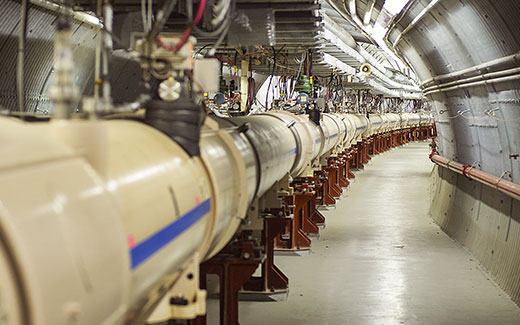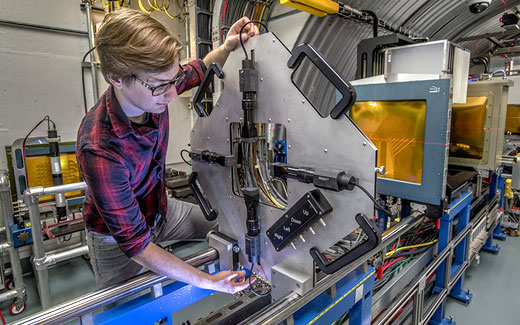
Exploring the building blocks of matter and the nature of space and time
Vibrant programs in experimental and theoretical research in nuclear and high-energy physics, accelerator design, and isotope production. Full mission statement
Our mission is to lead and support discovery-based, innovation-driven research at the frontiers of the subatomic world. We are world-leading in nuclear physics research, building and operating accelerator-based user facilities that serve international scientific communities. We also play a leading role in global particle physics programs that push the limits of precision and expand our understanding of the cosmos. Our pursuit of this fundamental and discovery research yields scientific and technological breakthroughs, and also applications that benefit society—such as radioisotopes used to support industrial, medical and national security needs.
| We're hiring! | A collaborative network of talent is crucial to our mission; see our philosophy. See available jobs |
Research Areas




International Collaboration
Nuclear & Particle Physics projects provide opportunities for scientists and engineers from around the world to build and discover with us, while bringing their science and technology expertise to the United States. As these collaborators share knowledge and expertise to address universal questions, they learn about one another's cultures, potentially breaking down barriers and creating bridges that foster connection and international cooperation.
DUNE Rubin LHC Belle II Daya Bay
Announcements
-
There are no announcements at this time.
NPP News
Facilities
The Nuclear and Particle Physics directorate operates the suite of particle / heavy ion accelerators used to carry out the program of accelerator-based experiments at Brookhaven National Laboratory. It supports the experimental physics program including design, construction and operation of the beam transports, and detector and research needs of the experiments.
Brookhaven Lab is building the world's first polarized electron-proton/ion collider, known as the Electron-Ion Collider (EIC). This discovery machine will unlock the secrets of the “glue” that binds the building blocks of visible matter.
Researchers from around the world use Brookhaven's Relativistic Heavy Ion Collider (RHIC) to study what the universe may have looked like in the first few moments after its creation by colliding two beams of gold ions at nearly the speed of light.
The NASA Space Radiation Laboratory (NSRL) uses beams of heavy ions from the accelerators that feed RHIC to simulate space radiation and study its effects on biological specimens—such as cells, tissues, and DNA—and industrial materials.
The Tandem Van de Graaff facility is a large electrostatic accelerator that can provide researchers with beams of more than 40 different types of ions, ranging from hydrogen to uranium.
The Brookhaven Linac Isotope Producer supports the Isotope Research and Production Department, preparing commercially unavailable radioisotopes for distribution to the nuclear medicine community and industry. Other supporting facilities include the Radionuclide Research and Production Lab and cyclotron.
The Scientific Data and Computing Center (SDCC) stores, distributes, and analyzes data for experiments at RHIC, the ATLAS experiment at the Large Hadron Collider in Europe, the Belle II experiment at Japan's SuperKEKB particle accelerator, and for certain Brookhaven Lab facilities and directorates.
With the exception of EIC (which is under construction) and SDCC, all facilities listed above are operated by the Collider-Accelerator Department.
Local and Global Impact
The world-leading science explored within the Nuclear and Particle Physics (NPP) Directorate—and the design and operation of technologies that make the science possible—generate benefits across a wide array of scientific fields and for society in general.
-
LEADERSHIP IN SCIENCE AND TECHNOLOGY

NPP projects attract the world’s best and brightest accelerator scientists, experimental and theoretical physicists, engineers, and technicians to tackle unique challenges and develop new technologies.
-
AN ECONOMIC ENGINE

NPP projects can drive economic advancement through the transfer of new technologies and knowhow to the commercial sector.
-
EDUCATIONAL OPPORTUNITIES

NPP projects offer countless educational opportunities for students from high school to graduate school, and for training a highly skilled workforce — the scientists, engineers, and tech-savvy workers who will tackle today’s scientific and technological challenges—and imagine and implement the advances of tomorrow.
-
JOBS

NPP projects support jobs — including in construction and other trades while facilities are being built, plus long-term highly skilled jobs in science, engineering, and technology for the duration of experimental operations.
-
MEDICAL ISOTOPES

Accelerators that support NPP’s nuclear physics programs also feed beams to the Brookhaven Linac Isotope Producer (BLIP). BLIP produces isotopes that are used to diagnose and treat diseases like cancer, as well as isotopes for industrial applications.
-
SPACE RESEARCH

The accelerators that support NPP’s nuclear physics programs also provide beams to the NASA Space Radiation Laboratory (NSRL). Scientists use NSRL to study how radiation damages cells, DNA, and electronics so they can devise ways to protect future astronauts and their spacecraft.
-
ADVANCED ACCELERATORS

NPP projects drive the evolution of innovative accelerator technologies that can also be used to explore properties of materials such as superconductors and batteries; study proteins involved in disease; deliver particle beam cancer therapy; make and test computer chips; and kill germs in our food supply.
-
MAGNIFICENT MAGNETS

Physicists and engineers working on NPP projects have designed and constructed sophisticated magnets for research facilities all around the world. Some of these magnet designs could be used in new types of energy storage or facilities for more efficient delivery of effective cancer treatments.
-
DETECTOR TECHNOLOGY

Technology developed for tracking particles in NPP experiments may be applied in medical imaging, to identify illicit cargo, and support other national security applications.
-
NUCLEAR SCIENCE EXPERTISE

Nuclear science provides the foundation for advances in nuclear medicine, for safely operating nuclear power reactors, and for a range of national security applications.
-
TACKLING BIG DATA

NPP experiments drive the development of powerful data-processing and analysis tools, including approaches that use machine learning and artificial intelligence. These tools can be applied to other data-intensive challenges such as understanding climate change; tracking global pandemics; and tackling challenges in national security.
A collaborative network of talent
Our work draws on an international community filled with unique voices and perspectives, all contributing their ideas and experiences. We are passionate about welcoming people from all backgrounds and helping them succeed. Collectively, we will expand the boundaries of science and technology, advance the knowledge of humankind, bring new applications to society, and further our understanding of the natural world.
Kayla
Patrick
Vanessa
Nora
Our commitment to safety
We are committed to ensuring that all staff have a safe and healthy working environment, protecting the general public and the environment from unacceptable environmental, safety and health risks, and operating in a manner that protects the environment by applying pollution prevention techniques to our activities.














